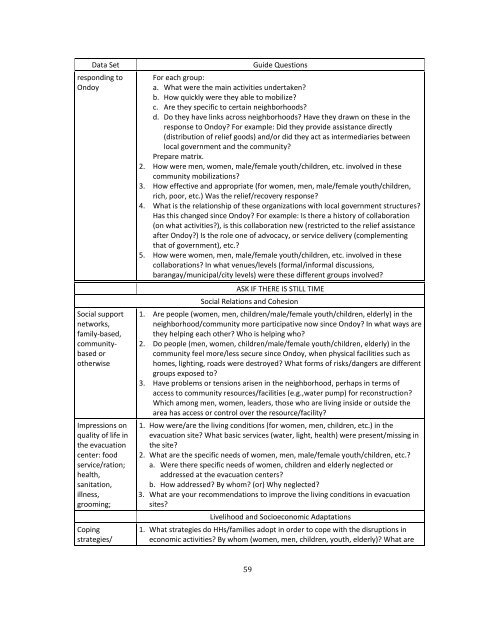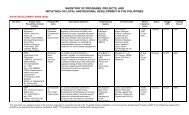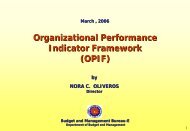rapid assessment of the social impacts of - Philippines Development ...
rapid assessment of the social impacts of - Philippines Development ...
rapid assessment of the social impacts of - Philippines Development ...
You also want an ePaper? Increase the reach of your titles
YUMPU automatically turns print PDFs into web optimized ePapers that Google loves.
Data Set Guide Questions<br />
responding to<br />
Ondoy<br />
Social support<br />
networks,<br />
family-based,<br />
communitybased<br />
or<br />
o<strong>the</strong>rwise<br />
Impressions on<br />
quality <strong>of</strong> life in<br />
<strong>the</strong> evacuation<br />
center: food<br />
service/ration;<br />
health,<br />
sanitation,<br />
illness,<br />
grooming;<br />
Coping<br />
strategies/<br />
For each group:<br />
a. What were <strong>the</strong> main activities undertaken?<br />
b. How quickly were <strong>the</strong>y able to mobilize?<br />
c. Are <strong>the</strong>y specific to certain neighborhoods?<br />
d. Do <strong>the</strong>y have links across neighborhoods? Have <strong>the</strong>y drawn on <strong>the</strong>se in <strong>the</strong><br />
response to Ondoy? For example: Did <strong>the</strong>y provide assistance directly<br />
(distribution <strong>of</strong> relief goods) and/or did <strong>the</strong>y act as intermediaries between<br />
local government and <strong>the</strong> community?<br />
Prepare matrix.<br />
2. How were men, women, male/female youth/children, etc. involved in <strong>the</strong>se<br />
community mobilizations?<br />
3. How effective and appropriate (for women, men, male/female youth/children,<br />
rich, poor, etc.) Was <strong>the</strong> relief/recovery response?<br />
4. What is <strong>the</strong> relationship <strong>of</strong> <strong>the</strong>se organizations with local government structures?<br />
Has this changed since Ondoy? For example: Is <strong>the</strong>re a history <strong>of</strong> collaboration<br />
(on what activities?), is this collaboration new (restricted to <strong>the</strong> relief assistance<br />
after Ondoy?) Is <strong>the</strong> role one <strong>of</strong> advocacy, or service delivery (complementing<br />
that <strong>of</strong> government), etc.?<br />
5. How were women, men, male/female youth/children, etc. involved in <strong>the</strong>se<br />
collaborations? In what venues/levels (formal/informal discussions,<br />
barangay/municipal/city levels) were <strong>the</strong>se different groups involved?<br />
ASK IF THERE IS STILL TIME<br />
Social Relations and Cohesion<br />
1. Are people (women, men, children/male/female youth/children, elderly) in <strong>the</strong><br />
neighborhood/community more participative now since Ondoy? In what ways are<br />
<strong>the</strong>y helping each o<strong>the</strong>r? Who is helping who?<br />
2. Do people (men, women, children/male/female youth/children, elderly) in <strong>the</strong><br />
community feel more/less secure since Ondoy, when physical facilities such as<br />
homes, lighting, roads were destroyed? What forms <strong>of</strong> risks/dangers are different<br />
groups exposed to?<br />
3. Have problems or tensions arisen in <strong>the</strong> neighborhood, perhaps in terms <strong>of</strong><br />
access to community resources/facilities (e.g.,water pump) for reconstruction?<br />
Which among men, women, leaders, those who are living inside or outside <strong>the</strong><br />
area has access or control over <strong>the</strong> resource/facility?<br />
1. How were/are <strong>the</strong> living conditions (for women, men, children, etc.) in <strong>the</strong><br />
evacuation site? What basic services (water, light, health) were present/missing in<br />
<strong>the</strong> site?<br />
2. What are <strong>the</strong> specific needs <strong>of</strong> women, men, male/female youth/children, etc.?<br />
a. Were <strong>the</strong>re specific needs <strong>of</strong> women, children and elderly neglected or<br />
addressed at <strong>the</strong> evacuation centers?<br />
b. How addressed? By whom? (or) Why neglected?<br />
3. What are your recommendations to improve <strong>the</strong> living conditions in evacuation<br />
sites?<br />
Livelihood and Socioeconomic Adaptations<br />
1. What strategies do HHs/families adopt in order to cope with <strong>the</strong> disruptions in<br />
economic activities? By whom (women, men, children, youth, elderly)? What are<br />
59




